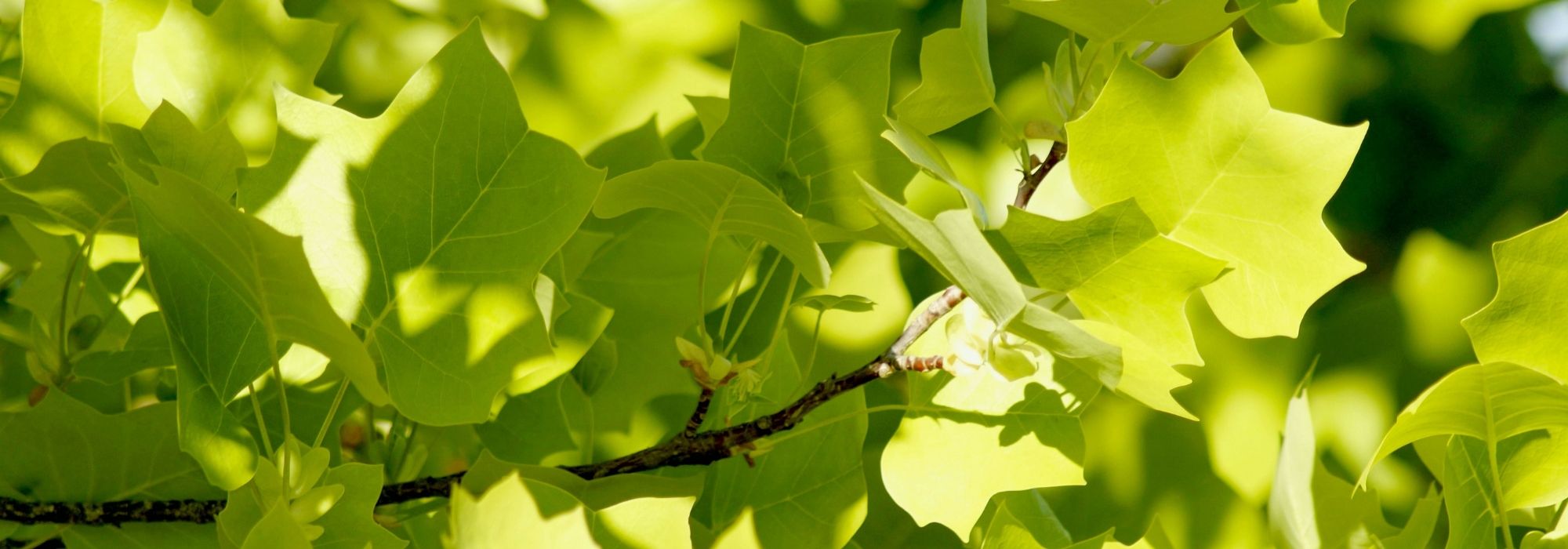
Tulip Tree, Liriodendron: planting, care
Contents
The Tulip Tree in a nutshell
- The Tulip Tree is a remarkable tree with its beautifully truncate leaves, green in spring turning to gold in autumn, and its unusual summer flowering.
- Its large greenish-yellow flowers, orange at the base, appear on older specimens and resemble the shape of a tulip.
- It is a tree that requires a bit of patience: it takes at least 10 years to enjoy its first flowers.
- A symbol of eternal life, the Tulip Tree has a lifespan of 500 years!
- Majestic, it is ideal for parks or large gardens.
A word from our expert
Liriodendron tulipifera or Tulip Tree is a remarkable tree known for its beautiful lobed leaves and curious flowers, both reminiscent of a tulip.
In summer, large flowers with broad petals exuding a lemony fragrance open into wide tulips of very light green to yellowish hues, tinged with orange at the base, on a green lobed foliage or yellow-margined (‘Aureomarginatum’), valued for its beautiful autumn colours.
Symbol of eternal life, the Tulip Tree is one of those trees that never die: it can live for over 400 years! And, as a little anecdote, in 1783, Queen Marie Antoinette had two Tulip Trees planted in the park of the Grand Trianon at the Palace of Versailles; had they not been swept away by a storm, they would still be alive today!
You will need to be very patient and count on at least 10 years to see its first flowers, and also reserve a location suitable for this tree, slight inconveniences considering the splendour and longevity of the Tulip Tree.
Elegant and majestic, with its large flowers in tangy shades, it brings an exotic and sophisticated touch to large parks and gardens in summer. Its mature height varies between 15 and 25 m, but some varieties, such as the Tulip Tree ‘Fastigiata’, of more modest stature, will fortunately suit medium-sized gardens better.
It is an easy tree to grow in full sun or partial shade, sheltered from cold, dry winds, in permanently moist soil, well-drained and rich in humus. It also offers a good hardiness that makes it resilient in all our regions.
Stunning when isolated on a lawn or in a strategic spot in the garden to enjoy its unique summer flowering, near a water feature or planted as a street tree, discover the Tulip Tree, this magnificent flowering tree related to magnolias!
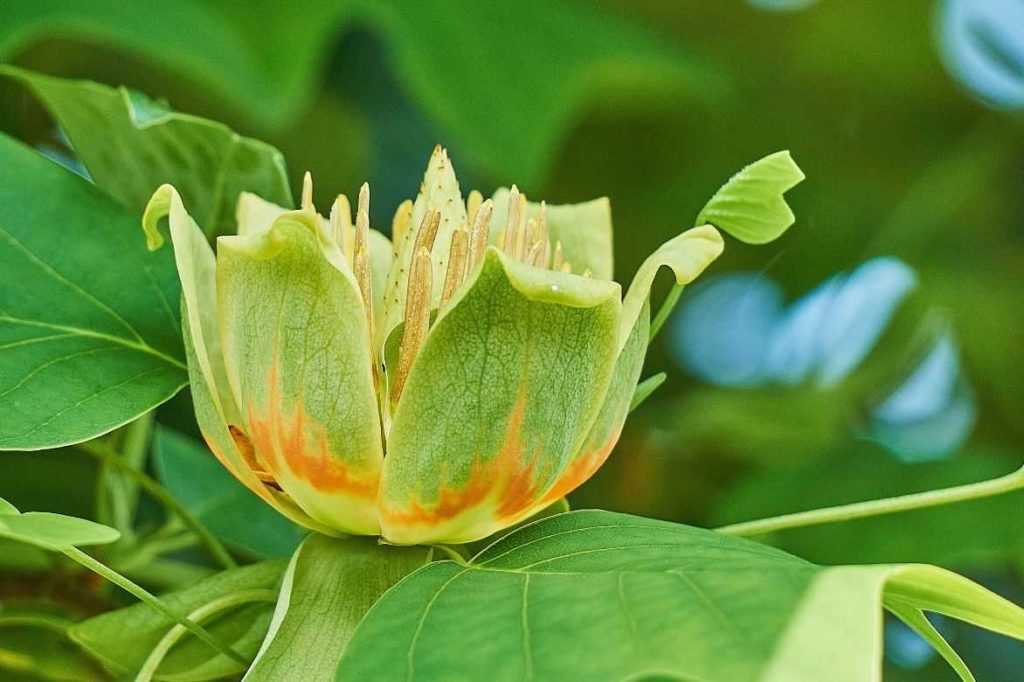
Description and Botany
Botanical data
- Latin name Liriodendron tulipifera
- Family Magnoliaceae
- Common name Tulip Tree
- Flowering May to August depending on the climate
- Height Between 15 and 25 m
- Exposure Sun, partial shade
- Soil type All types of soil, moist
- Hardiness below -15°C
The Liriodendron tulipifera or Tulip Tree is a large deciduous tree from the Magnoliaceae family, native to the central-western and eastern United States, where it grows spontaneously along waterways and on mountain slopes.
The genus contains only two species, including Liriodendron tulipifera, which has given rise to several varieties, such as Liriodendron tulipifera ‘Fastigiata’, which differs from the typical species by its fastigiate, narrower habit, and Liriodendron chinensis, or Chinese Tulip Tree, which is smaller and less hardy than the Tulip Tree.
Anchored by a deep taproot, the Tulip Tree forms a majestic tree with a straight trunk and a columnar habit, its branches spreading into a conical crown that broadens over time. In the case of Liriodendron tulipifera ‘Fastigiata’, the crown is narrower, and the branches are almost parallel to the trunk. Taller than wide, it can reach 50 m in height with a trunk diameter of 2 to 3 m in its natural habitat.
In our gardens, its adult size will be limited to 15 to 25 m in height and about 15 m in width. Its growth is rapid, especially in the first few years after planting, then sometimes slows to the point of appearing stagnant, but its longevity is exceptional; the Tulip Tree can live for nearly 500 years.
The bark is smooth and grey-orange when the tree is young, then darkens and cracks with age, which has led to this tree being commonly referred to as “yellow wood.”
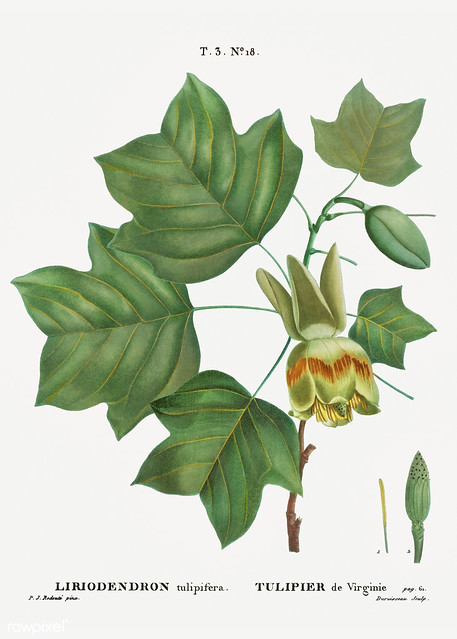
Liriodendron tulipifera – botanical illustration by PJ Redouté
The Liriodendron tulipifera is a remarkable tree with its beautifully truncated leaves that are almost as spectacular as its flowering.
Its deciduous leaves, alternate and borne on very long petioles up to 10 cm, are nearly as wide as they are long, measuring 10 to 16 cm. The Tulip Tree owes its name to their distinctive shape that draws attention. The lamina, divided into 4 symmetrical and pointed lobes separated by well-marked notches, appears truncated at the tip. In these curiously lobed leaves that end in a point, some see the shape of a tulip, a lyre, or even a saddle.
These glossy leaves are light green to vivid green with a glaucous underside in spring. The Liriodendron tulipifera ‘Aureomarginatum’ stands out with particularly bright foliage, irregularly edged in golden yellow in spring.
The entire tree dons a remarkably flamboyant outfit in autumn. The leaves turn shades of golden yellow, tobacco brown, or lovely orange hues in autumn before falling.
The Liriodendron tulipifera is characterised by an unusual summer flowering. From May to July, after the leaves have emerged, enormous cup-shaped flowers appear on trees aged at least 10 to 20 years. Nestled within the foliage, they bloom solitary at the tips of the branches. Their elongated shape recalls both the tulip, hence the species name, as well as the natural elegance of the fleur-de-lis and the grace of magnolia flowers.
These flowers 6 cm to 10 cm in diameter consist of 9 tepals, with 3 sepals surrounding 6 waxy, thick petals. The inside of the cup reveals a central white-cream cone surrounded by a bouquet of yellow stamens measuring 4 to 5 cm long.
They bloom in corollas shaded in very fresh, tangy colours from light green to white or pale yellow-green tinged with orange at the base.
The nectar-rich flowers are melliferous and slightly fragrant, emitting a pleasant lemony citrus scent.
They then transform, but only after 20 years, into light brown conical fruits measuring 7-8 cm long, upright and scaly, resembling those of magnolia.
They persist on the tree long after the leaves have fallen and release numerous small winged seeds (achenes or samaras) that are a feast for birds and small animals in winter.

Evolution of the stunning flowering of the Tulip Tree
With excellent hardiness, the Tulip Tree withstands harsh winters down to -30 °C, sometimes even beyond. It prefers a sunny to partially shaded exposure and rich, deep, well-drained soils that remain moist throughout the year.
The Liriodendron tulipifera is a splendid tree when planted alone, as a focal point in a large park or garden to enjoy its spectacular flowering, near a large pond, or as a street tree. Some varieties of more modest stature will suit medium-sized gardens well.
The wood of the Tulip Tree, which is yellow-brown to green-brown in colour, is a lightweight and soft timber highly valued in marquetry, in lutherie, and in shipbuilding.
The bark also possesses anti-inflammatory and cough-relieving properties and can be used as a substitute for quinine.
Main species and varieties
With the type species Liriodendron Tulipifera, only a few varieties of Tulip tree are commonly offered in nurseries. Here are our favourites!
The most popular

Liriodendron tulipifera - Tulip Tree
- Période de floraison June to August
- Hauteur à maturité 25 m
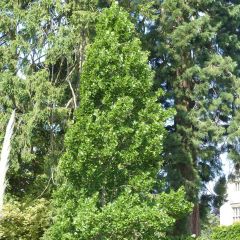
Liriodendron tulipifera Fastigiatum - Tulip Tree
- Période de floraison June to August
- Hauteur à maturité 15 m
Our favourites
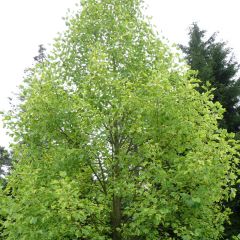
Liriodendron tulipifera Aureomarginatum - Tulip Tree
- Période de floraison June to August
- Hauteur à maturité 15 m
Planting the Liriodendron
Where to Plant the Tulip Tree?
The Liriodendron tulipifera or Tulip Tree exhibits excellent hardiness, down to -30°C, sometimes -35°C, allowing it to be planted in the coldest regions of our country. Native to wet areas, it thrives in rainy climates and will likely be less comfortable in the overly dry Mediterranean regions.
Although very hardy, in regions with long winters or strong winds, provide it with a well-sheltered spot as late frosts can damage flower buds and strong winds can break its branches.
It prefers a non-scorching sunny exposure or partial shade in rich, light, deep, well-draining soil that is cool, even moist in winter, but not too dry, as it requires some moisture in the soil to thrive. While it is tolerant like the magnolia, it will prefer slightly acidic and low-calcium soil.
This tree does not transplant well and does not appreciate heavy pruning or trimming; therefore, think carefully about the location before planting and allow it enough space as, at maturity (after 40 to 50 years of growth), it will easily exceed 20 m in height and 15 m in width.
Its monumental dimensions make it a prime specimen for planting as a solitary tree in a large park or garden, as well as in alignments in urban settings, as it shows perfect resistance to pollution. It will also look splendid near a water feature.
In a medium-sized garden or a city garden, opt for the Liriodendron tulipifera ‘Fastigiata’, a less cumbersome variety, growing slightly slower than the standard type and with a narrower habit, which does not exceed 15 m in height and 6-7 m in spread.
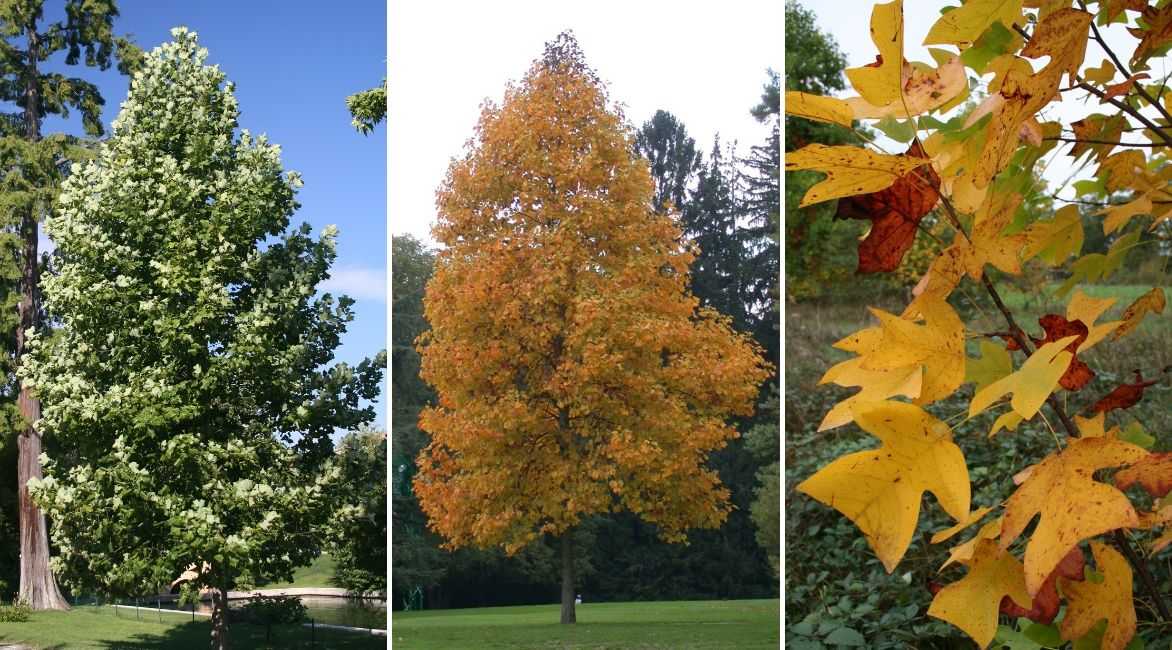
Change in foliage colour of the Tulip Tree through the seasons
When to Plant the Tulip Tree?
The planting of the Tulip Tree should ideally be done in spring from February to April in cold regions or from September to November in other regions to encourage rooting before winter. In all cases, avoid periods of frost.
How to Plant the Tulip Tree?
The secret to a beautiful Tulip Tree is to ensure the soil is rich, deep, and cool! In very calcareous soil, we recommend adding heather soil at planting. Once well established, avoid moving it, as its roots do not tolerate transplantation well. Allow it sufficient space at least 8 to 10 m between its base and another tree, wall, or fence.
- Plant it in a wide hole at least three times the volume of the root ball
- Create a good draining bed to prevent water stagnation using coarse sand or gravel
- Enrich the soil with well-matured compost and a bit of potting soil
- Plant it at collar level without burying the root ball too deeply
- Keep the tree upright and stake if necessary
- Firm the soil and water generously until it takes root, as well as during the two summers following planting
- Mulch the base to retain moisture during summer
To successfully plant your tree, check out our video!
Maintenance, pruning and care
The Tulip Tree requires very little maintenance. A good layer of mulch and regular watering in summer are the main aspects of care.
In summer, monitor its water needs during the first two years and water generously during dry spells. Spread a good layer of organic mulch to keep the soil consistently moist. Its growth can be hindered by a lack of water, so the soil should never be dry. After this period, it will be more resilient to brief droughts.
Once a year, in spring, amend the soil with a good organic fertiliser.
Should the tulip tree be pruned?
The Tulip Tree does not appreciate frequent or severe pruning: only prune if necessary in the case of broken, weak, or poorly placed branches. At the end of winter, carry out maintenance pruning solely to remove dead or damaged wood. Apply a tree tar as each wound encourages the entry of pathogenous fungi.
Learn more in our tutorial: How to prune a Tulip Tree?
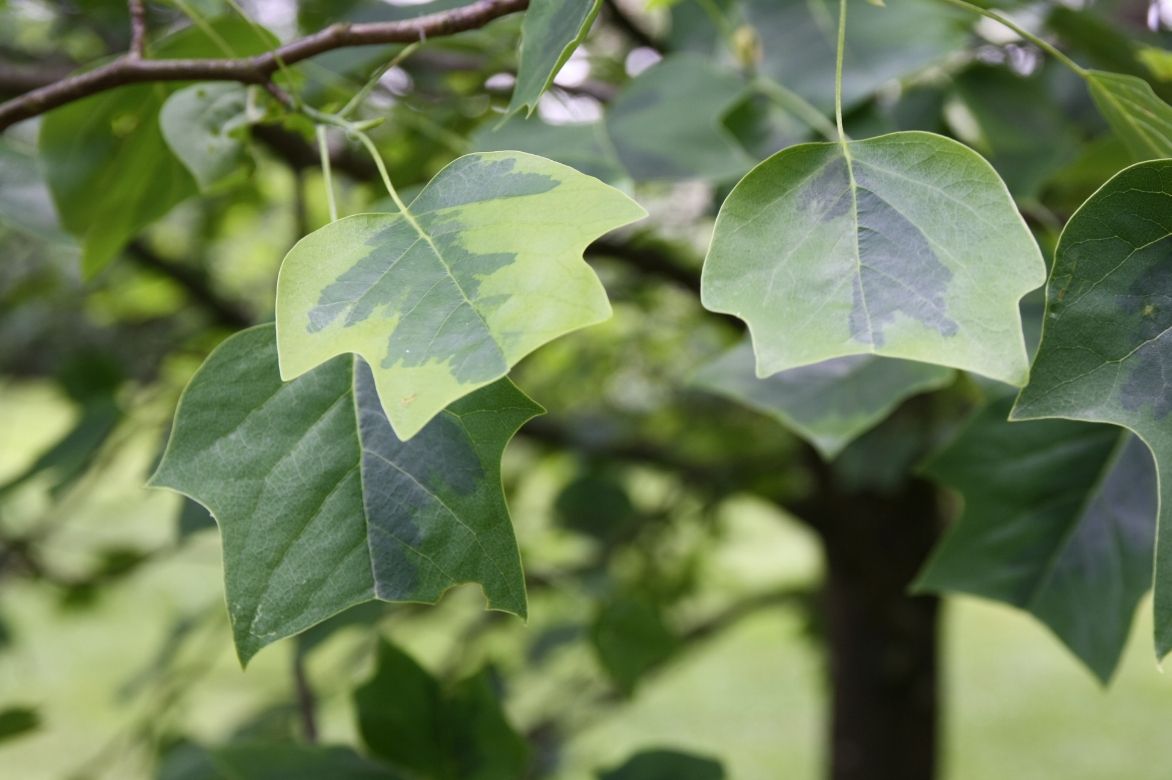
Stunning variegated foliage of Liriodendron tulipifera ‘Aureomarginatum’
Diseases and potential pests
Installed in suitable growing conditions, the Tulip Tree is not very susceptible to most diseases as well as attacks from insects or parasites.
In waterlogged and poorly drained soil, it will be threatened by cryptogamic diseases caused by fungi such as verticillium wilt. As a preventive measure: spray Bordeaux mixture in autumn and late winter. In case of an attack, you will notice that the leaves wilt, dry out, and curl in on themselves: remove the affected leaves and burn them.
Soil that is excessively calcareous can lead to chlorosis, causing yellowing of the leaves and ultimately the decline of the tree. Regularly amended soil with a handful of heather soil will help prevent its occurrence.
→ Learn more with our dedicated page on Diseases and pests of the Tulip Tree.
Multiplication
The tulip tree is propagated by sowing; it can sometimes take an entire year for the seeds to germinate or by grafting for the more experienced gardeners. However, as the fruits of the Tulip tree only appear after 20 years, we recommend purchasing another tulip tree from our nursery instead.
→ Learn more about propagating Liriodendron in our tutorial How to propagate the tulip tree?
Associate
The Tulip Tree requires a large space; it generally stands alone and will be remarkable in striking punctuation amidst a lawn. Highly resistant to pollution, it is perfect for a large city garden. Its yellow-green-orange flowering invites the use of zesty harmonies or complementarity, pairing it with blue-toned flowers for contrasting associations.
This tree, with its imposing habit, will become the focal point at the centre of a large bed of shorter shrubs that will bloom earlier in spring, such as Mahonia Media with its lemon-yellow flowers, Chimonanthus praecox with its sulphur-yellow flowering, forsythias, or later bloomers like a Buddleja weyeriana ‘Sungold’, shrubby potentillas, creeping roses, or Hypericum ‘Golden Beacon®’ or St. John’s Wort.
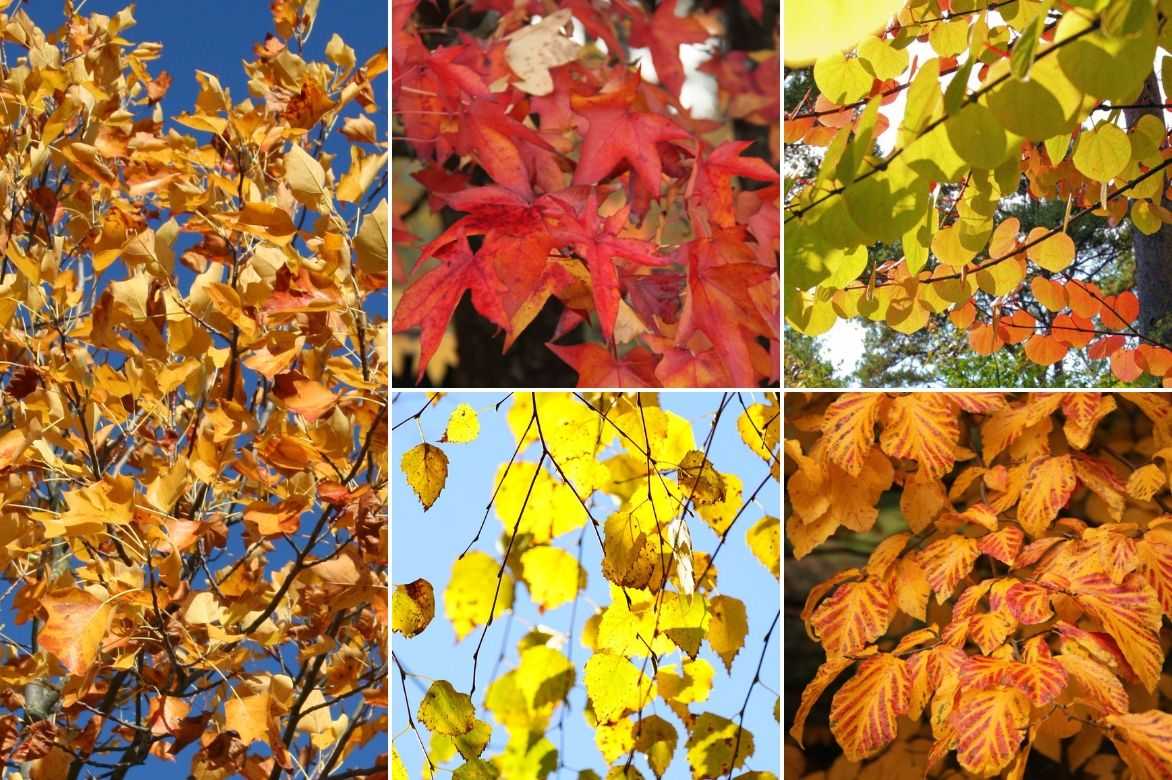
An example of a grove association: Liriodendron tulipifera, Liquidambar styraciflua, Cercidiphyllum japonicum, Betula utilis (B. utilis var. jacquemontii for example), Parrotia persica… in autumn, it will be a fireworks display of colours!
A Lonicera nitida Elegant, a hardy honeysuckle, will form a perfect low hedge around its base.
In spring, surround it with a carpet of bulbs, such as Imperial Fritillaries, Eremurus, Daffodils, narcissi, late tulips.
Its lush foliage in summer limits light at its base, so choose some cool shade perennials with yellow or blue flowers, such as Brunnera macrophyll, creeping Bugle, Corydalis, Foxgloves, or hardy geraniums to keep its roots cool.
The lavender-blue panicles of a Buddleia davidii ‘Nanho Blue’ and the cobalt-blue flowers of a Ceratostigma willmottianum, a ground-covering shrub, will provide a striking contrast with the yellow flowering of the Tulip Tree that will also stand out beautifully against a backdrop of blue conifers such as Cedrus libani atlantica ‘Glauca’, Cupressus arizonica ‘Fastigiata’, or Chamaecyparis lawsoniana ‘Columnaris’.
At the end of the season, the leaves of a Caramel Tree (Cercidiphylum japonicum) or a Persian Ironwood will enhance its autumn foliage.
Useful resources
- Discover our tips for properly planting the Tulip Tree.
- Do you have a small garden but wish to plant a tree? Fortunately, there are species and varieties of modest size; discover our selection of trees for small gardens!
- Everything you need to know about trees is on our blog!
- The most beautiful trees and large bushes are in our nursery!
- Discover our collection of summer-flowering shrubs that could accompany your Tulip Tree!
- Discover 7 trees with unusual foliage
Frequently asked questions
-
Why is my tulip tree losing its leaves?
Native to riverbanks, this tree requires moist soil throughout the year. Dry ground should be avoided. In case of water shortage, the tulip tree may lose its leaves. During summer, monitor water needs, especially for young trees, and water generously during the first two years after planting to ensure establishment. The soil should never be dry.
-
Why isn't my Tulip Tree flowering?
Planting a Tulip Tree in the garden is about embracing the school of patience! It takes many years before it blooms. You won't see its first flowers until after 8 to 15 years of cultivation.
- Subscribe!
- Contents
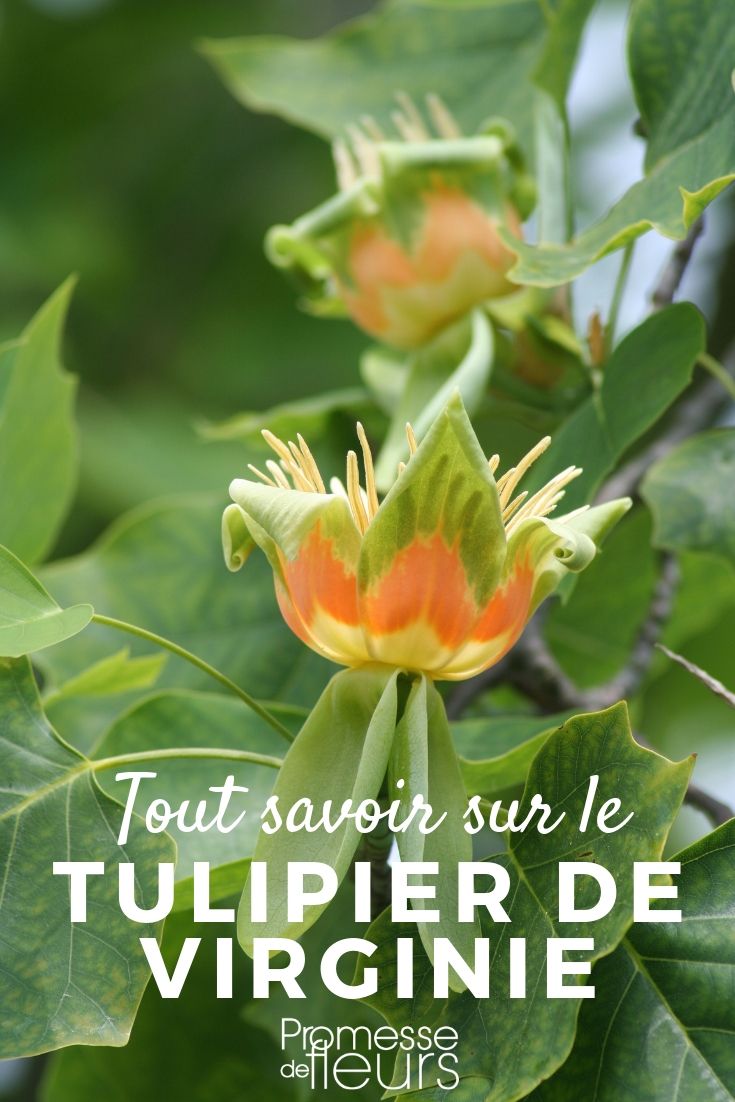































Comments